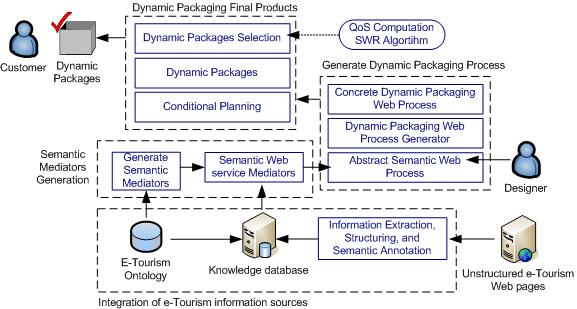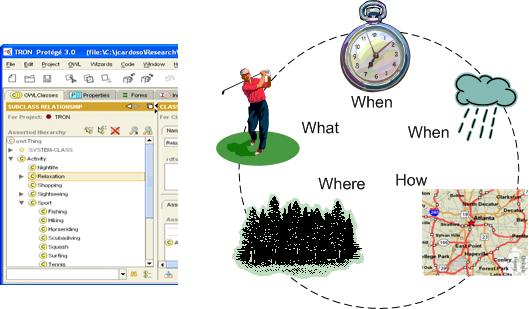
Figure 1. Overall system architecture
Jorge Cardoso
Departamento de Matemática e EngenhariasAbstract. One important type of e-tourism applications that has surfaced in recent years is dynamic packaging systems. Dynamic packaging is critical to today's travel industry, such as airlines, hotels, tour operators and travel agencies, to create custom packages to consumers. Our objective is to develop a platform to enable dynamic packaging using the latest Internet tech-nologies, such as semantic Web, Ontologies, Web services, and Web processes.
Keywords: e-Tourism, dynamic packaging systems, semantic Web, ontologies, Web services, Web processes, information systems integration.
Tourism has become the world's largest industry and its growth shows a consistent year to year increase. The World Tourism Organization [1] predicts that by 2020 tourist arrivals around the world would increase over 200%. Tourism has become a highly competitive business for tourism destination over the world. Competitive ad-vantage is no longer natural, but increasingly driven by science, information technol-ogy and innovation.
The Internet is already the primary source of tourist destination information for travelers. About 95% of Web users use the Internet to gather travel related informa-tion and about 93% indicate that they visited tourism Web sites when planning for vacations [2]. The number of people turning to the Internet for vacation and travel planning has increased more than 300% over the past five years.
Tourism Information Systems (TIS) are a new type of business systems that serve and support e-tourism and e-travel organizations, such as airlines, hoteliers, car rental companies, leisure suppliers, and travel agencies. One class of these systems relies on travel related information sources, such as Web sites, to create tourism products and services. The information extracted from these sources can serve as the springboard for a variety of tasks, including dynamic packaging, travel planning, and price com-parison.
We are particularly interested in studying the development of dynamic packaging applications. Dynamic packaging can be defined as the combining of different travel components, bundled and priced in real time, in response to the request of the con-sumer or booking agent.
Our approach to the development of a dynamic packaging platform encompasses the use of the latest information technologies such as semantic Web, Web services, and Web processes. E-tourism is a perfect application area for semantic Web tech-nologies, since information dissemination and exchange are the key backbones of the travel industry.
Our architecture to develop a dynamic packaging infrastructure has four major phases: integration of e-Tourism information sources, semantic mediator generation, dynamic packaging process generation, and dynamic packaging final products. All the compo-nents that are used in each phase are illustrated in Figure 1. Due to space limitation, we will only briefly describe each phase.

Figure 1. Overall system architecture
After studying several travel, leisure, and transportation online sites, we found out the lack of standards in the tourism domain. Some of the differences founded among sev-eral sites are the following:
Our objective is find a solution to surpass this lack of standards in the tourism field by automatically understanding the different ways of expressing tourism products and services, extracting its relevant information and structuring. We argue that sophisti-cated technologies, such as semantics and ontologies, are good candidates to enable the development of dynamic packaging information systems.

Parallel to our work, a working group at DERI [3] is also constructing an ontology for the tourism industry. Our approach differs - it is objective-oriented - the ontology is able to answers four types of questions (Figure 2) that can be asked when develop-ing a dynamic package. These questions involve the predicates What, Where, When, and How. Examples of typical questions are:
With the growth of the Web, all types of tourism information providers already have homepages for storing the description of tourism services and products. A dynamic packaging infrastructure requires integrating data in an automated way for querying in a uniform way and across multiple heterogeneous Web sites containing tourism re-lated information.
In our project, we rely on semantic annotation [7] to resolve the differences among the data present in distinct e-Tourism Web sites. Semantic annotation is the process of inserting tags in documents, whose purpose is to assign semantics to the text between the opening and closing tags. Unstructured Web pages are annotated using the e-Tourism ontology. The semantically annotated pages are then stored in a knowledge database.

Each mediator gathers and integrates semantic information from its children. In this structure, the leaves are records of information coming from e-Tourism data sources which were semantically annotated.
Abstract Web process. An abstract Web process [8] specifies the control-flow and data-flow of an application, but does not define which Web services will be executed at runtime. Abstracting away the resource descriptions allows Web processes model-ing dynamic packages to be portable and reused to generate different process instance at runtime.
For example, Figure 5 shows an abstract Web process designed to construct a dy-namic package that includes a fishing experience in the morning, takes the tourist for shopping, schedules a golf game or a movie in the afternoon, and a dinner at night

Dynamic Packaging Web Process Generator. Concrete dynamic package Web processes are automatically created using a suitable generator. In this step, the genera-tor may optimize the concrete process based on the availability of Web services. Each service in the abstract Web process is turned into an executable service by specifying the locations of the Web service implementation.
Concrete Dynamic Packaging Web Process. An abstract Web process typically originates several concrete processes. Each Web process invokes different Web ser-vices. At this point, the processes are valid from a functional point-of-view, but they may not generate valid dynamic package due, for example, to time or cost constraints.
Final dynamic package processes are created using conditional planning, ranking, and selection. We envisage using a conditional planning approach to allow the generation of correct dynamic packages. The main objective of the planning is to schedule an appropriate timeframe during which the tourist will realize a particular activity refer-enced by a dynamic package.
After using conditional planning, all the dynamic packages are valid. Nevertheless, some packages may take more time to execute than others or be more expensive for the tourist, i.e. they have a distinct QoS (Quality of Service)[9]. For these reasons the next phase is responsible for ranking and selecting the packages which have a set of characteristics that is more similar with the tourist requirements. To compute the QoS of each package process, we use the SWR algorithm [9, 10]. Once dynamic package processes are evaluated, they are presented to the tourist. Finally, the tourist can select the package that he founds more appealing or suitable according to his preferences.
Dynamic packaging is the key for the future of the tourism industry. Dynamic packag-ing can be defined as the combination of different travel components, bundled and priced in real time, in response to the requests of the consumer or booking agent.
In this paper we have describe an architecture that we will be developing in the next two years as part of a funded project (POSI/EIA/56164/2004) on e-Tourism. Our approach encompasses the use of the latest information technologies such as semantic Web, ontologies, Web services, and Web processes to deploy a generic and reusable platform do construct and deploy dynamic packaging solutions. We believe that the construction of such a system will represent a significant step towards the semantic Web and the adoption of modern information systems in the tourism industry.
1. WTO, World Tourism Organization. 2005.
2. Lake, D., American Go Online for Travel Information, in CNN. 2001.
3. DERI, E-Tourism Working Group. 2005, DERI International.
4. Uschold, M. and M. Gruninger, Ontologies: Principles, methods and applications. Knowledge Engineering Review, 1996. 11(2).
5. Protégé, Protégé. 2005, Stanford Medical Informatics.
6. OWL, Web Ontology Language (OWL). 2004, World Wide Web Consortium (W3C).
7. Kiryakov, A., et al., Semantic Annotation, Indexing, and Retrieval. Journal of Web Semantics (Elsevier), 2005. 2(1).
8. Akkiraju, R., et al. Executing Abstract Web Process Flows. in Workshop on Planning and Scheduling for Web and Grid Services, ICAPS. 2004. Whistler, British Colum-bia, Canada.
9. Cardoso, J., et al., Modeling Quality of Service for workflows and web service proc-esses. Web Semantics: Science, Services and Agents on the World Wide Web Jour-nal, 2004. 1(3): p. 281-308.
10. Cardoso, J., Stochastic Workflow Reduction Algorithm. 2002, LSDIS Lab, Depart-ment of Computer Science, University of Georgia.